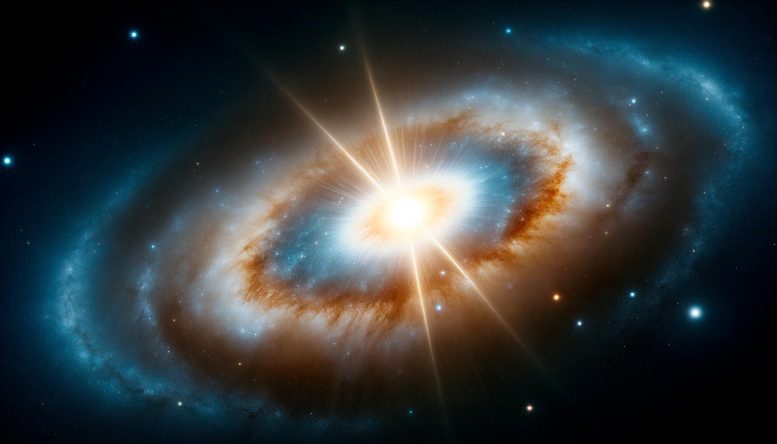
The LST Collaboration’s detection of the distant quasar OP 313 at very high energies showcases the LST-1 telescope’s capabilities. This groundbreaking observation of the most distant AGN challenges current astrophysical understanding and paves the way for further explorations of the universe. Credit: SciTechDaily.com
LST-1’s discovery of the distant quasar OP 313 at high energies marks a milestone in astronomy, highlighting the telescope’s advanced capabilities in exploring the farthest reaches of the universe.
On December 15, the Large-Sized Telescope (LST) Collaboration announced through an Astronomer’s Telegram (ATel) the detection of the source OP 313 at very high energies with the LST-1. Although OP 313 was known at lower energies, it had never been detected above 100 GeV, making this the LST-1’s first scientific discovery. With these results, OP 313 becomes the most distant Active Galactic Nuclei (AGN) ever detected by a Cherenkov telescope, further showcasing the LST prototype’s exceptional performance while it is being commissioned on the CTAO-North site on the island of La Palma, Spain.
The Nature and Observation of OP 313
OP 313 is what is known as a Flat Spectrum Radio Quasar or FSRQ, a type of AGN. These are very luminous objects found in the centers of some galaxies, where a supermassive black hole devours material from its surroundings, creating powerful accretion disks and jets of light and relativistic particles.
The LST-1 observed this source between December 10 and 14, after receiving an alert from the Fermi-LAT satellite that showed unusually high activity in the low-energy gamma-ray regime, confirmed also in the optical range with different instruments. With just four days of data, the LST Collaboration was able to detect the source above 100 Gigaelectronvolts (GeV), an energy level a billion times higher than the visible light humans can perceive.
Challenges in Detecting Distant Quasars
Only nine quasars are known at very high energies, and OP 313 is now the tenth. In general, quasars are more difficult to detect at very high energies than other types of AGN. This is not only because the brightness of their accretion disk weakens the emission of gamma rays, but because they are further away. In this case, OP 313 is located at a redshift of 0.997 or ~8 billion light years away, making it the most distant AGN and the second most distant source ever detected at very high energies.
The more distant the source, the more difficult it is to observe at very high energies due to the so-called Extragalactic Background Light or EBL. The EBL is the collective light emitted by all objects outside the Milky Way that expands across multiple wavelengths, from visible, infrared, and ultraviolet. The EBL interacts with very high-energy gamma rays, attenuating their flux and, thus, making their observation challenging. The characteristics of the LST-1, with an optimized sensitivity for the CTAO’s low energy range, between 20 and 150 GeV, where gamma rays are less affected by the EBL, enabled the LST Collaboration to extend the study of this source to tens of GeV for the first time.
The LST Collaboration will continue to observe this source with the LST-1 to expand the dataset and, thus, obtain a more precise analysis that allows scientists to improve their understanding of the EBL, study the magnetic fields within this type of source, or delve into fundamental intergalactic physics.

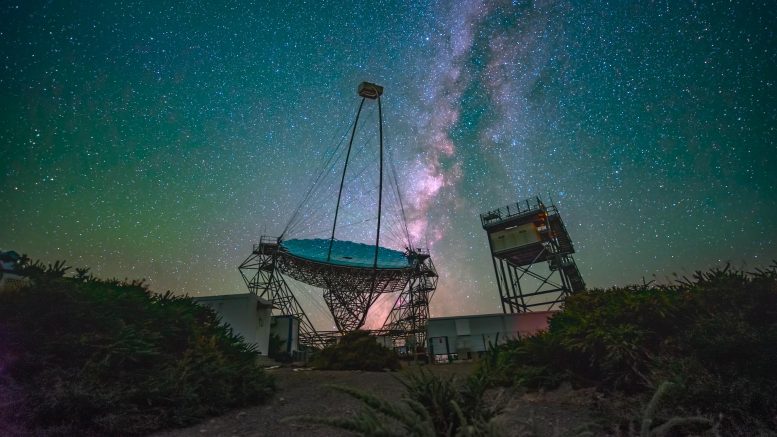

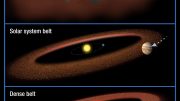
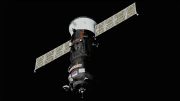
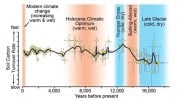
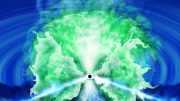

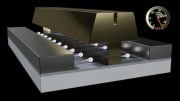
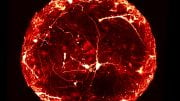
Although, for example, Kerr’s BH model is impressive, event horizons revealing extreme spin, and other energetic events originating close to an event horizon, are better explained using an increased light speed there.
Most useful thing about extra-dimensional (especially AdS) space seems to be that mathematically “flattening” away the supposed extra-dimensionality can be ignored where it’s peripheral. That’s also helpful because ultimately any usefulness to be found in cosmological extra-dimensionality is nonexistent, considering the loss of constant “c.” It also means variable time-rate/distance metric in flattened AdS can be replaced with a variable lightspeed, making lensing, simply enough, a shortest-time/least-resistance concept. These aspects of AdS space still fit into the central idea of a “quantum space” constructed of gravity-influenced “standard vacuum springs” embodying a variable gravity vacuum permittivity/permeability model of space moderating information flows in light. Gravitational frequency shifting is photon distortion in flattened AdS space, a real “light clock” appropriately carries no time-rate shift information after its gravitometric information is discounted.
When deSitter (dS) space (“gravity funnel” space, “gravity well” space, Einstein space) gets mathematically “flattened.” elongated metrics in the “well” become compressed metrics by which it might be said that as one approaches the “bottom of the well,” what happens is “the rate of time slows down,” which is to say that light-waves and meters are most stretched (“reddening” is greatest) for light emitted from the gravity source at the bottom of the “gravity funnel.” In this Einstein space, photon redness is supposed to be maintained by shifts of metric everywhere as it moves away from the center of the well, color can’t be changed in that way, color is considered intrinsic to the photon and in this way it maintains information on the gravitational time-rate at the source.
In contrast, when anti-deSitter space, a mound-like “anti-Einstein” space, one lacking room for a hole as the gravity generator in the center, is mathematically flattened, the shortest metrics of the space, namely the metrics at the boundary far removed from the center, are shortened even further. This is how flattened anti-deSitter space operates on light in ways “complementary” to flattened deSitter space. Most importantly, dS “reddening” is replaced with AdS “blueshifting” nearest to the center, and this “anti-reddening” effect depends upon (changes with) the observer’s location.
An interesting elaboration on these concepts, which also should not require citations, especially as this is supposed to be a friendly informal comment site where elaborations to basic physics concepts shouldn’t be considered off limits, is to suppose the rate of information conduction under gravity can be variable depending on an extent that light energy along the path of gravitational action may be excluded (my Van Flandern gravity nod). The reality appears to be that it’s unlikely to be a black-and-white issue, but it may remain a gray one, also one that may darken and contract as everything cools.